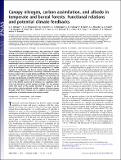Canopy nitrogen, carbon assimilation, and albedo in temperate and boreal forests: Functional relations and potential climate feedbacks

View/
Author
Ollinger, S. V.
Martin, M. E.
Hollinger, D. Y.
Frolking, S. E.
Reich, P. B.
Plourde, L. C.
Katul, G. G.
Oren, R.
Smith, M.-L.
Paw U, K. T.
Bolstad, P. V.
Cook, B. D.
Day, M. C.
Martin, T. A.
Monson, R. K.
Schmid, H. P.
Note: Order does not necessarily reflect citation order of authors.
Published Version
https://doi.org/10.1073/pnas.0810021105Metadata
Show full item recordCitation
Ollinger, S. V., A. D. Richardson, M. E. Martin, D. Y. Hollinger, S. E. Frolking, P. B. Reich, L. C. Plourde, et al. 2008. “Canopy Nitrogen, Carbon Assimilation, and Albedo in Temperate and Boreal Forests: Functional Relations and Potential Climate Feedbacks.” Proceedings of the National Academy of Sciences 105 (49) (December 3): 19336–19341. doi:10.1073/pnas.0810021105.Abstract
The availability of nitrogen represents a key constraint on carbon cycling in terrestrial ecosystems, and it is largely in this capacity that the role of N in the Earth's climate system has been considered. Despite this, few studies have included continuous variation in plant N status as a driver of broad-scale carbon cycle analyses. This is partly because of uncertainties in how leaf-level physiological relationships scale to whole ecosystems and because methods for regional to continental detection of plant N concentrations have yet to be developed. Here, we show that ecosystem CO2 uptake capacity in temperate and boreal forests scales directly with whole-canopy N concentrations, mirroring a leaf-level trend that has been observed for woody plants worldwide. We further show that both CO2 uptake capacity and canopy N concentration are strongly and positively correlated with shortwave surface albedo. These results suggest that N plays an additional, and overlooked, role in the climate system via its influence on vegetation reflectivity and shortwave surface energy exchange. We also demonstrate that much of the spatial variation in canopy N can be detected by using broad-band satellite sensors, offering a means through which these findings can be applied toward improved application of coupled carbon cycle–climate models.Other Sources
https://www.ncbi.nlm.nih.gov/pmc/articles/PMC2593617/Terms of Use
This article is made available under the terms and conditions applicable to Other Posted Material, as set forth at http://nrs.harvard.edu/urn-3:HUL.InstRepos:dash.current.terms-of-use#LAACitable link to this page
http://nrs.harvard.edu/urn-3:HUL.InstRepos:29405785
Collections
- FAS Scholarly Articles [18262]
Contact administrator regarding this item (to report mistakes or request changes)


